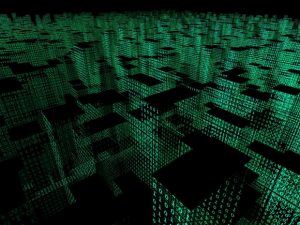Picture all of the universe covered with dominoes that, as they fall over, another domino from behind stands it up. In my brain it looks more like a slinky, but the dominos are a better representation for a switch, (on/off, yes/no, one/zero) as they fall down and stand up. This is machine language, like the displays in the movies when they want you to see incomprehensible computer operation. The dark screen fills with ones and zeros.
Virtual reality is built out of linear toggles, like dominoes, that are read only in association with several others near them, usually in groups of 8 (or 16 or 32 or 64). This group of switches or codes is the building block for everything else. Bigger ones, smaller ones, red ones, multicolored. When you zoom in close you can see the dominoes in waves or every surface. Zoom in even closer and you can see individual dominoes fall and rise. But what we see when we take in the picture is the shimmer of slinky-like dominoes building a matrix that constructs our every shape, picture movement and dance.
This is how virtual reality shapes our worlds. We use codes, switches, like dominoes to build a reality that is not made of atoms, molecules, sea, air, earth and animals. Virtual reality is made from our manipulation of switches to generate, according to rules, algorithms, formula that are understandable. If it is understandable then it works.
Virtual reality, then, is just like our human reality except that virtual reality is guided by humans and human reality is not. Well, that isn’t true either. Human reality is also guided by humans. The world we live in is built by stone and mortar and wood and water, word, ideas, education, inspiration and work.
So no difference is there between worlds generated by virtual dominoes or day laborers. We come and go, play our games, generate our production, supply what others need in exchange for what we need according to societal norms in a world that is increasingly less and less physical.
A word hardly exists. In ink on paper, in a wisp of the air, or electronic dominoes flashing by. But our human world could hardly exist without words. Human existence, as it is today, is dependent upon that mostly non-existent word. As virtual reality is based upon the domino-like binary switch, our human reality is based upon the word, the idea, the structure and the meaning. And the word is the only part of that basis which may have some sort of physical existence. The word can represent the idea, the structure and the meaning, but meaning et.al. can have no physical existence.
Our world is rational, non-physical. We make models in our heads which represent recognizable patterns we can communicate to others. If others understand then it works. If it works we have produced, like the virtual reality programmers. We have used the available universe of rules, relationships, aspects and attributes to reach another. We have built a world, and that world has very, very little existence in the physical realm. We live in a conceptual reality called Rational Existence.
The difference between RE and Virtual Reality is foremost that VR is known to be of our own construction, and RE is generally thought to be physical. But physical reality is without concept. Without concepts for trees or falling who cares about the woods? Does a tree fall in the woods if there is no reality built of ideas that contains trees or falling?
The constructs we make with words and models and relational concepts are communicated in words and drawings and photos and movies. We see and understand grand notions like Justice, absurdities like digging a hole only to fill it again, and philosophical existentialism or phenomenology. But when examined at its most basic foundation, human reality is a tautology. What is more valuable to humantity than value itself? The answers to all our questions are in the words we used to ask the questions.